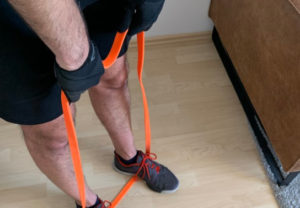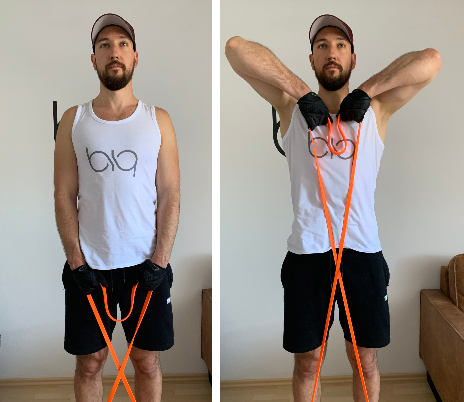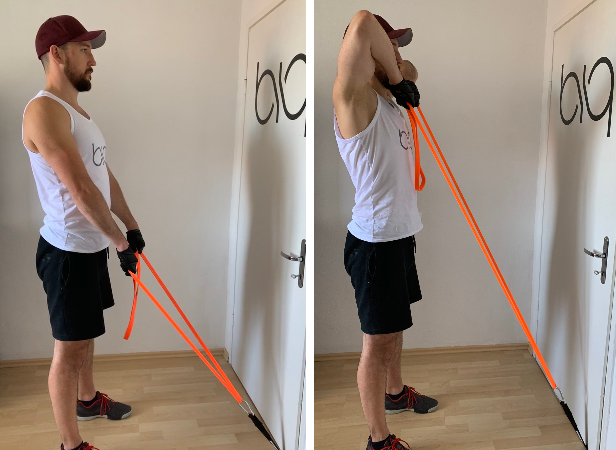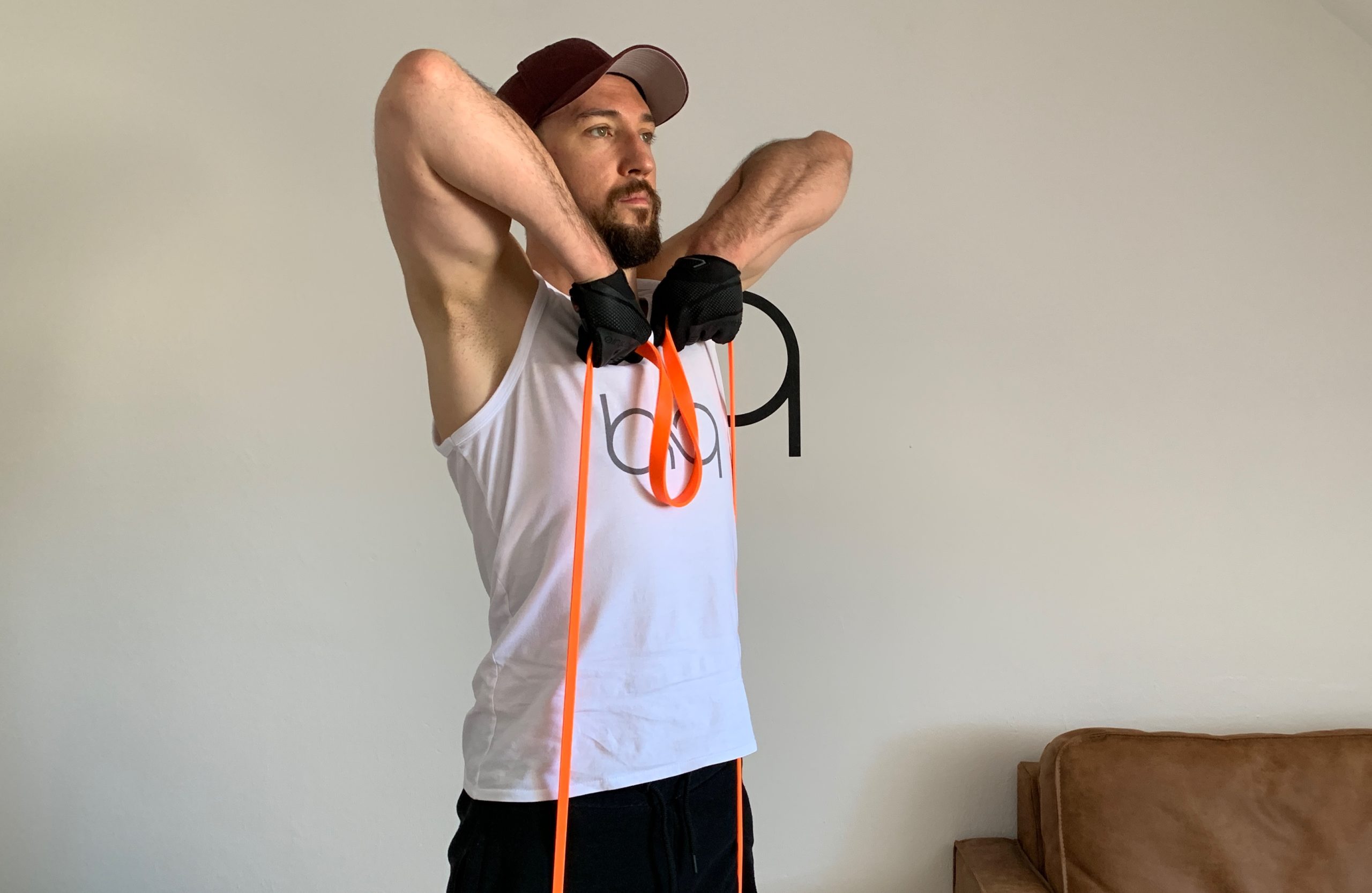Upright Rows are a really popular exercise to train your lateral delts as well as hitting your traps and bicep as well. This exercise has been getting some negative image lately due to problems with high by joint stress but resistance bands can give you a joint-friendly version of the upright row that is a great alternative to doing it with a bar or dumbbells.
In the first part of this article, I will show you how to execute an upright row with resistance bands properly and in the second part, you find some tips to make the upright press harder and more effective to get you the pump you’re looking for.
Upright Row With Resistance Band
Let’s jump right into how you do the basic upright row with resistance bands.
Band VS Weights
Doing your upright row with a resistance band gives you several advantages over doing them with a machine or with free weights.
- Don’t leave results on the table! You are leaving results on the table by using either the wrong resistance bands or the wrong workout plan. No worries, we got you covered – take our free workout plan tailored for your goals here and make sure to check out our perfectly tuned set of resistance bands here.
- Follow the natural strength curve of your muscle! The resistance of a band will always increase the more you stretch it and that’s also the natural strength curve of your muscle, having the most power in the full contraction. With a cable machine or weights, you often fatigue in the expanded part of your muscle without fully fatiguing the whole muscle.
- Joint Friendly & Less Disbalances! When using a bar you’re more fixed in your hand position and put more stress on your joints while bands let you get in a more natural hand position and prevent injuries.
- Better Range Of Motion! If you use a bar or dumbbells, you will have them in your way at the end of the movement. A resistance band is a lot better here because it is not larger than your hand and you can get right into the full contraction.
There are also more reasons to favor resistance bands over traditional free weights or machines, like reducing the stress on your joints, getting more peak contraction, and many more. But we’re talking here about doing a chest press, so if you’re interested in background info about what benefits resistance bands give you in strength training and bodybuilding, check it out here.
How To Upright Row The Right Way
The main focus of the upright row is the side delts and you will put your focus on them by raising your hands right in front of your body using primarily the side delts (with some extra stability of the biceps and traps).

Get into an upright standing position with a neutral spine (don’t put your face in front or lean back during this exercise), put your shoulders back and stick your chest out. You basically get into a neutral standing position without rounding your shoulders at all.
Now get the resistance band below your feet in a shoulder-width stand and grab the end of the band about shoulder-width as well. The band will form kind of a rectangle if you would now look in the mirror.
Now raise the band up and think about raising your elbows instead of the band, this helps using the delts and not the bicep.
Important Do’s & Don’ts!!!
⓵ Neutral Grip – a big advantage doing this exercise with a resistance band and not something static like a bar is that you will not put extra stress on your wrists and shoulders because the bar will force you into an unnatural position.
This exercise has not the best reputation due to the high stress on wrists and shoulders, but doing with a resistance band will help you prevent that automatically as you can turn your hands during the exercise naturally and you’re not limited to a bar.
Still, don’t rise higher than the chin height, everything above that will only put stress on your shoulders and not contract your muscles more!
 ⓶ No Slack – the band should be pre-stretched at your standing position, there shouldn’t be any slack or you will lose a lot of time under tension and slow down the amount of work your muscles has to do (slower progress).
⓶ No Slack – the band should be pre-stretched at your standing position, there shouldn’t be any slack or you will lose a lot of time under tension and slow down the amount of work your muscles has to do (slower progress).
If you can’t get the band up without slack in the band you need to drop to a lighter band and pre-stretch it more.

We have the best workout plan for resistance band training out there - and you can get it for free!Answer the 4 questions below and we send it to you, no strings attached!
Alternative Ways To Upright Row With Resistance Bands
With every version of an exercise, you will find people that really like it and others that don’t like it that much. If you have problems with the traditional way of doing the upright row as shown above (while executing it the right way), you might want to try one of the alternative ways.
Cross The Bands – I like this variation here a lot when you cross the bands. The perfect movement for your side delts are not directly vertical but also to the outside (looking at the lateral raises you understand this motion). By crossing the bands over each other, you will get the direction of the resistance in the band perfectly for hitting your side delts.

Anchored Upright Raises – this is an alternative that will target your traps and rhomboids a little bit more as you don’t vertically row up and it’s also a good variation if you find it harder to adjust the resistance with your stance and the grip on the band perfectly.
 Simply anchor the resistance band at floor level with a door anchor or wrap it around a heavy piece of furniture and do your upright row while standing not too far away from that point. Still keep in mind to keep your hands shoulder-width apart.
Simply anchor the resistance band at floor level with a door anchor or wrap it around a heavy piece of furniture and do your upright row while standing not too far away from that point. Still keep in mind to keep your hands shoulder-width apart.
Overload Upright Rows Right
To make progress you need to work the muscle to failure with the right resistance to fully fatigue your muscle while doing enough reps.
With upright rows this can be challenging adjusting resistance, but here are some things you can do to add resistance before switching to a stronger resistance band.
Leg Position – your legs are great to do minor adjustments. If you just switched to a stronger band you can only use one foot, this is the absolute minimum of resistance you can get from a band here. If you’re not able to get a full set with this setup, you need to use a lighter band.

If you use a lighter band but need to add resistance, you want to make a wider stance. The optimal position is having your legs shoulder-width but you can also step further apart to create more resistance and still do the upright rows in perfect form.
 I really don’t recommend you to wrap the band around your hands, this will put more stress on your wrists and start pulling your hands together what we already discussed above.
I really don’t recommend you to wrap the band around your hands, this will put more stress on your wrists and start pulling your hands together what we already discussed above.
Time Under Tension – compared to weights where you have the same force applied to any position of the movement, bands will add more resistance the further you stretch them – this will lower the time under tension your muscle has during a set in the starting position. Focus on doing the exercise controlled and try to hold it for a second or two in the fully contracted position and don’t let the band snap back but slowly go back to the starting position.
Full Shoulder Workout
Simply doing upright rows is not a full shoulder workout as there are multiple muscles working in your shoulders – we have here a full shoulder workout with different exercises that will give you the strongest pump you can ever think of – check it out here.



